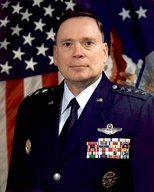
|

|
|
|
|
General Jumper was born in Paris, Texas, a child of cotton farmers. His father was Jimmy (not James) Jefferson Jumper. Looking "probably for a way to get out of Paris, Texas," John remarks, Jimmy enlisted in the U.S. Army Air Forces, near the end of World War II, became a pilot, and retired as a two-star general, "having never gone to college." While his father was serving in the occupation of Japan, John and his mother traveled aboard a liberty ship to join him. A resident of Burke, Virginia, Jimmy completed his military career as Chief of Staff United States Air Force. John, in following his father from post to post, attended "about twenty schools to get through twelve grades". Meanwhile, he grew up "in the shadow of heroes," he remarks. Chuck Yeager was a family friend, while the Mercury Seven astronauts lived on the same street while his father was stationed at Langley Air Force Base in Virginia. After high school John entered Virginia Military Institute. The school's Honor Code impressed him. "You get this powerful feeling of the power of character in your life and you make a virtue of it," he says. "You tend to find that VMI people are honest, extremely honest, high integrity, high character." At VMI he joined Air Force R.O.T.C. while working towards a degree in electrical engineering. He graduated and was commissioned a second lieutenant in June of 1966. He took pilot training at Moody Air Force Base in Valdosta, Georgia, and C-7 Caribou training at Stuart Air Force Base in Nashville, Tennessee. He completed survival school at Fairchild in Florida and jungle training in the Philippines. By October of 1967 he was in Vietnam in combat. The C-7, he remarks, was the "perfect airplane to support the Special Forces." John served in 459th Tactical Airlift Squadron at Phu Cat Air Base. He was part of the unit based in Da Nang. In the Tet Offensive, starting in January of 1968, he flew missions into Khe Sanh, typically flying six out of seven days a week. With North Vietnamese troops surrounding the city, he flew in supplies of whole blood, then took off before the enemy spotted his aircraft. Most days he transported supplies into Special Forces camps, often requiring "six or seven" hours a day, many in 20-minute hops. "You'd fly twelve to fifteen sorties a day into a place that had a five-hundred foot strip," he recalls. When airstrips were not usable during monsoon, he'd do airdrops, including livestock such as cows, pigs, and big baskets of chickens. Special Forces camps butchered livestock to share with local villages. He dropped arms and ammunition to camps by flying at 300 feet, pull the nose up, and let the loadmaster in back pull the pin out of loads attached to parachutes. He also medevacked soldiers and Vietnamese civilians. John married Ellen McGhee on Easter Weekend of 1969, and then returned for his second tour in Vietnam, this time flying F-4s from Udorn, Thailand as a forward air controller, often concentrating on targets along the Ho Chi Minh Trail. "You went down low a lot then, just trying to find targets under trees or in trees," he remarks. John was in the Triple Nickel (555th Fighter Squadron). He often escorted "Jolly Greens" (CH-53 Sikorsky helicopters) on rescue missions. Meanwhile, his father was a general and flew the RF-4 Phantom jet in Vietnam. Soon after John finished his second Vietnam tour he served in England from 1970 to 1974. As years went by in his career, he flew most aircraft, including the F-22. John rose to the rank of general and commanded squadrons, wings, and numbered air forces. |


